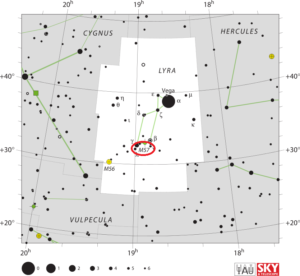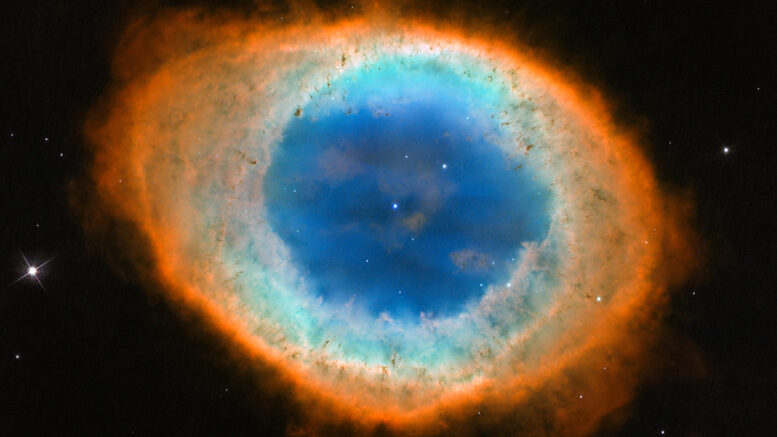Messier 57, otherwise known as the Ring Nebula, is a planetary nebula, the glowing remains of a sun-like star. The tiny white dot in the center of the nebula is the star’s hot core, called a white dwarf. M57 is about 2,000 light-years away in the constellation Lyra, and is best observed during August. Discovered by the French astronomer Antoine Darquier de Pellepoix in 1779, the Ring Nebula has an apparent magnitude of 8.8 and can be spotted with moderately sized telescopes. The ring is tilted to face Earth.
| Description | |
| Visible From Pacific Northwest | April to September |
| Best Time To Observe | June and July |
| Minimum Size Of Viewing Device | 8 inch telescopes |
| Object Type | Planetary Nebula |
| Designations | Messier 57, M57, NGC 6720, Ring Nebula, PK 063+13 1, GC 4447, BD+32 3246, CSI+32-18517, VV 214, WD 1851+329, GSC2 N0223131306, PN G063.1+13.9 |
| Right Ascension | 18h 53m 35.079s |
| Declination | +33°01’45.03” |
| Constellation | Lyra |
| Age | 6,000 to 8,000 years |
| Apparent magnitude | +8.8 |
| Apparent dimensions | 230” x 230” |
| Object Radius | 1.3 light years |
| Distance From Earth | 2,300 light years |
History
The Ring Nebula was discovered by the French astronomer Antoine Darquier de Pellepoix in January 1779. He would go onto note:
This nebula, to my knowledge, has not yet been noticed by any astronomer. One can only see it with a very good telescope, it is not resembling any of those already known; it has the apparent dimension of Jupiter, is perfectly round and sharply limited; its dull glow resembles the dark part of the Moon before the first and after the last quarter. Meanwhile, the center appears a bit less pale than the remaining part of its surface.
French astronomer Antoine Darquier de Pellepoix
Charles Messier discovered the object independently on January 31, 1779.
Locating M57 In The Sky
Messier 57 lies to the south of Vega, the brightest star in Lyra and one of the stars that form the Summer Triangle, a prominent asterism found overhead in the summer sky. The nebula is easy to find as it is located roughly 40 percent of the distance from Sheliak, Beta Lyrae, to Sulafat, Gamma Lyrae. The best time of year to observe M57 is in the summer months.

Viewing M57
The nebula cannot be resolved in small binoculars and is best seen in 8-inch and larger telescopes. Even smaller telescopes will reveal the nebula’s ring shape, while medium-sized instruments will also show its interior hole.
Photographing M57
Messier 57 is a very popular target for astrophotographers and there are plenty of astrophotographers who have posted their experiences online that can work as guides. One can use an unmodified DSLR to get a beginner image and then return the The Ring Nebula after gaining much experience and see the difference that this experience can make.
M57 is a very good target for beginner astrophotographers, as it compensates for its small size by being very bright on camera, meaning you do not need to spend hours and hours on it to get beautiful results.
https://www.galactic-hunter.com/post/m57-the-ring-nebula
Sources And Further Reading
Descriptions of all of Messier Objects can be found here.
https://www.nasa.gov/feature/goddard/2017/messier-57-the-ring-nebula/
https://www.messier.seds.org/m/m057.html

Leave a comment